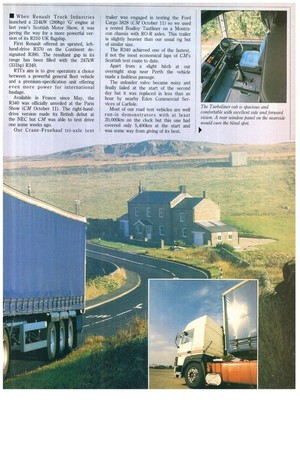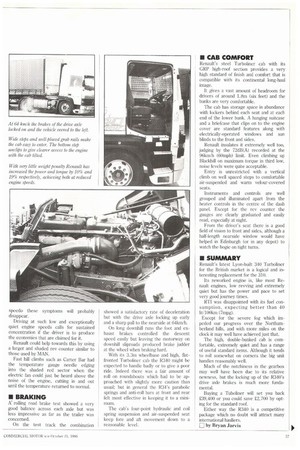TURBOLINER BREEZES IN
Page 56

Page 57

Page 58

Page 59

If you've noticed an error in this article please click here to report it so we can fix it.
Higher power, higher roof, higher standards — the new Renault R340 Turboliner is a worthy successor to the R310 as flagship of RT1's UK range
• When Renault Truck Industries launched a 214kW (289hp) G' engine at last year's Scottish Motor Show, it was paving the way for a more powerful version of its R310 UK flagship.
First Renault offered an uprated, lefthand-drive R370 on the Continent designated R390. The resultant gap in its range has been filled with the 247kW (331hp) R340.
RTI's aim is to give operators a choice between a powerful general fleet vehicle and a premium-specification unit offering even more power for international haulage.
• Available in France since May, the R340 was officially unveiled at the Paris Show (CM October 11). The right-handdrive version made its British debut at the NEC but CM was able to test drive one some weeks ago.
Our Crane-Fruehauf tri-axle test trailer was engaged in testing the Ford Cargo 3828 (CM October 11) so we used a rented BoaHoy Tautliner on a Montracon chassis with RO-R axles. This trailer is slightly heavier than our usual rig but of similar size.
The R340 achieved one of the fastest, if not the most economical laps of CM's Scottish test route to date.
Apart from a slight hitch at our overnight stop near Perth the vehicle made a faultless passage.
The unloader valve became noisy and finally failed at the start of the second day but it was replaced in less than an hour by nearby Eden Commercial Services of Carlisle.
Most of our road test vehicles are well run-in demonstrators with at least 20,000km on the clock but this one had covered only 5,400km at the start and was some way from giving of its best.
• ENGINE
The R340 uses the same basic MIDR 06.35.40 air-to-air charge-cooled 12 litre unit as the R310 but the G-version has improved breathing and fuel injection as well as a number of important engineering changes.
Redesigned piston rings are used, for example, while cylinder head bolts replace studs and nuts for better sealing.
Renault has also fitted five-hole injectors with revised settings in place of fourhole components.
In place of a KKK turbocharger Renault uses a Garrett T51 with the larger air cleaner fitted on the R390. A French-built Livit speed limiter is also fitted as standard on all '300' series engines.
More power and torque at 100rpm less must have raised the engine's operating temperature and Renault has made a number of cooling system changes to counter this.
A new crankshaft pulley is used which allows a higher running speed for the nine-bladed fan to give better cooling than the six-bladed fan on the R310.
• DRIVEUNE
The R340 uses the same 430mm diameter clutch and Renault's B18 18-speed synchromesh range-change splitter gearbox with overdriven top three gears as the R310. A new 4.82 final drive is used in order to get the best out of the R340's 247kW engine.
Three optional ratios are available, from the high-speed 4.556:1 to the 5.125:1 (also standard on the R310) and the deeper 5.857:1.
• PERFORMANCE
The engine improvements have resulted in slightly lower specific fuel consumption within and just below its optimum torque band of 1,150-1,300rpm.
Beyond 1,500rpm fuel consumption increases, looking quite ordinary at 1,900rpm where the R340 delivers its peak power.
Running in eighth high or low ratios between 64 and 80Iurvh has the engine spinning along very smoothly at around 1,200rpm at near-maximum torque and at its fuel-efficient best. Using its peak torque to best advantage the R340's acceleration is deceptively quick with times very similar to the Mer cedes 1633S and only two seconds behind the MAN 19.361 up to 80km/h.
It showed good lugging qualities, too, pulling up most of Shap at about 651un/h in eight-low only once needing seven-high. Beattock required just one split, apart from the roadworks near the summit.
Whereas a split generally takes care of most gentle gradients, steeper ones needed a full gear change and before the revs had fallen below 1,300 rpm.
Starting from rest normally required the use of second, fourth, fifth and sixth low, then splitting each of the remaining gears. Most of the lower gears felt stiff and notchy, making gearchanging on the severe gradients of the A68 section slower than desirable.
With a few more kilometres on the speedo these symptoms will probably disappear.
Driving at such low and exceptionally quiet engine speeds calls for sustained concentration if the driver is to produce the economies that are claimed for it.
Renault could help towards this by using a larger and shaded rev counter similar to those used by MAN.
Fast hill climbs such as Carter Bar had the temperature gauge needle edging into the shaded red sector when the electric fan could just be heard above the noise of the engine, cutting in and out until the temperature returned to normal.
• BRAKING
A' rolling road brake test showed a very good balance across each axle but was less impressive as far as the trailer was concerned.
On the test track the combination showed a satisfactory rate of deceleration but with the drive axle locking up early and a sharp pull to the nearside at 64km/h.
On long downhill runs the foot and exhaust brakes controlled the descent speed easily but leaving the motorway on downhill sliproads produced brake judder at the wheel when braking hard.
With its 3.3m wheelbase and high, flatfronted Turboliner cab the R340 might be expected to handle badly or to give a poor ride. Indeed there was a fair amount of roll on roundabouts which had to be approached with slightly more caution than usual; but in general the R34's parabolic springs and anti-roll bars at front and rear felt most effective in keeping it to a minimum.
The cab's four-point hydraulic and coil spring suspension and air-suspended seat keep fore and aft movement down to a reasonable level.
• CAB COMFORT
Renault's steel Turbotiner cab with its GRP high-roof section provides a very high standard of finish and comfort that is compatible with its continental long-haul image.
It gives a vast amount of headroom for drivers of around 1.8m (six feet) and the bunks are very comfortable.
el'he cab has storage space in abundance with lockers behind each seat and at each end of the lower bunk. A hanging suitcase and a briefcase that clips on to the engine cover are standard features along with electrically-operated windows and sun blinds to the front and sides.
Renault insulates it extremely well too, judging by the 72dB(A) recorded at the 96km/h (60mph) limit. Even climbing up Blackhill on maximum torque in third low, noise levels were quite acceptable.
Entry is unrestricted with a vertical climb on well spaced steps to comfortable air-suspended and warm velour-covered seats.
Instruments and controls are well grouped and illuminated apart from the heater controls in the centre of the dash panel. Except for the rev counter the gauges are clearly graduated and easily read, especially at night.
From the driver's seat there is a good field of vision to front and sides, although a half-length nearside window would have helped in Edinburgh (or in any depot) to watch the bogie on tight turns.
• SUMMARY
Renault's latest Lyon-built 310 Turboliner for the British market is a logical and interesting replacement for the 310.
Its reworked engine is. like most Renault engines, low revving and extremely quiet but has the power and pace to set very good journey times.
wri was disappointed with its fuel consumption, expecting better than 40 lit/100km (7mpg).
Except for the severe fog which impeded our progress over the Northumberland hills, and with more miles on the clock it may well have achieved just that. The high, double-bunked cab is comfortable, extremely quiet and has a range of useful standard items. Although it tends to roil somewhat on corners the big unit handles reasonably well.
Much of the notchiness in the gearbox may well have been due to its relative newness, but the locking up of the R340's drive axle brakes is much more fundamental.
Buying a Tuboliner will set you back 239,400 or you could save £2,700 by opting for the standard roof.
Either way the R340 is a competitive package which no doubt will attract many international hauliers.
E by Bryan Jarvis




































































































































